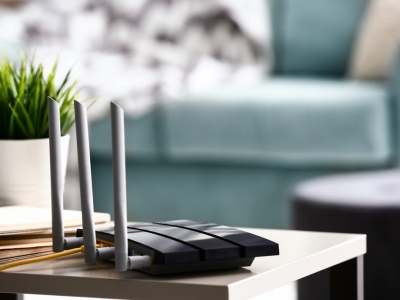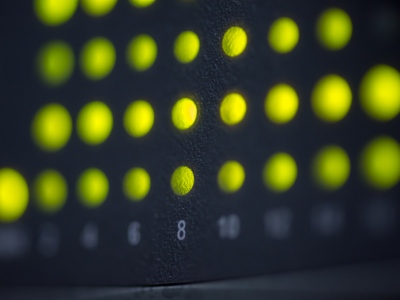
On any network, storage space is a precious commodity that dwindles quickly in proportion to the number of users using it. Throw in the fact that most will want to store and share media files, and network administrators will find themselves scrambling to acquire an additional storage solution soon. In the home, dual-drive storage rigs may be adequate, but a far better choice would be D-Link’s 4-Bay Network Storage Enclosure DNS-343, available in RAID Level 5 configuration and roomy enough for further expansions.
At 5.1 by 7.9 by 7.2 inches, the enclosure can easily nestle atop a tower PC. The case is composed of a black matte finish in some parts and brushed metallic in other areas. The D-Link logo is carved into the left and right paneling. If this is not enough, the logo is also manifested in front along with a power button and another one marked Next. A yellow OLED backlight completes the look.
The buttons need substantive finger pressure to depress them, which is a bit annoying. The power button is self-explanatory. The Next button enables flipping amongst a trio of status screens. The first screen is for System and will contain information such as the device’s IP address and the host’s name, the current version of the firmware and the temperature within the device in real time. The second is called the Hard Drive screen and will display the amount of used storage space and the current RAID status. The last screen, Server, will inform users about the status of printer, iTunes, FTP, and UPnP audio-video servers connected to the enclosure.
At the back is found a USB port and a Gigabit Ethernet port, in addition to a reset button and the jack where the power cable is plugged into. A printer or UPS monitor can be plugged via the USB port. The drive slots can eject their resident drives using four individual levers for this purpose. The whole enclosure requires no tools to dismantle or re-assemble it, so switching out the drives is easy. Users can take out the interior from the case by simply raising the faceplate and fishing out the interior. Each bay has its own SATA connector and a slot where the drive is mounted. The setup precludes the use of tools for removing screws or clamps when mounting or dismounting the drives.
The aforementioned Server screen hints at the various features the DNS-343 comes with. It does lack an auto-download function for BitTorrent, which is common in several other NAS systems. The interface is web-based and intuitive, with setup and user- or group-account management a breeze. It is even possible to set storage and access limits, as well as sharing privileges to each account. Power can be set to switch off after a certain period of idleness. The enclosure may be configured to send out e-mail alerts in case of drive failure or if the drives have reached their maximum storage capacities. The alerts can also inform the administrator if the unit is overheated. Soft shutdown and rebooting, upgradable firmware and a ScanDisk utility complete the system maintenance suite. The interface is reminiscent of other D-Link offerings, in that helpful tips are displayed whenever a feature is used. For instance, a tip about port-forwarding will present itself in the screen when doing an FTP server setup. Memeo AutoBackup utility is also included within the CD installer, along with Easy Search to assist users in locating the device on the network where it is being added to.
The DNS-343’s installation process is pretty straightforward. A 4 x 160GB drive set can be installed by simply connecting the device to a router via the Ethernet port and turning the DNS-343 on. After the device boots up and is assigned an IP address, the drives can then be configured to the desired RAID setting. Choices for this range from high-performance RAID 0 striping, RAID 1 for redundancy, or RAID 5 to combine both. Other options are to set the drives to run independently, or even in JBOD mode. A hybrid JBOD-RAID custom configuration is also possible.
In the redundant RAID 1 mode, the device still boasts of phenomenal transfer speeds. A test showed that it needs a little more than eight minutes to write a 10GB folder, which is more than twice as fast as a few other NAS devices in the market. The same can be said of read speeds, taking six and a quarter minutes to read the same 10GB folder.
One minor caveat of the DNS-343 is the noisy onboard two-fan cooling system, which is louder than the average PC power supply. Personnel in a small office setup might not even notice the noise, but it can become downright disturbing when used in the home.
Brushing this aside, the device holds a lot of advantages as a NAS solution that will invariably blow users away. Incredible throughput and the capacious extra space for additional storage form part of its strong selling points. Veteran networkers and novices alike will be impressed by the simple setup and maintenance of this multi-featured enclosure.








Comments